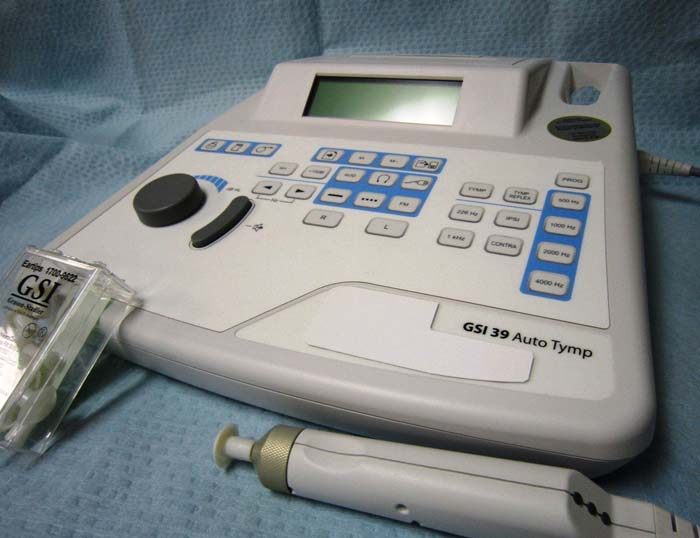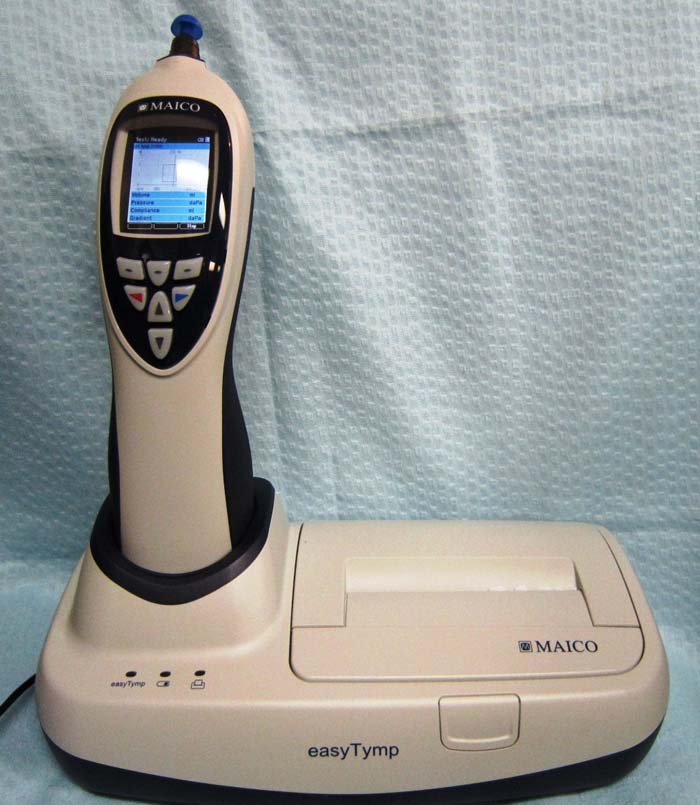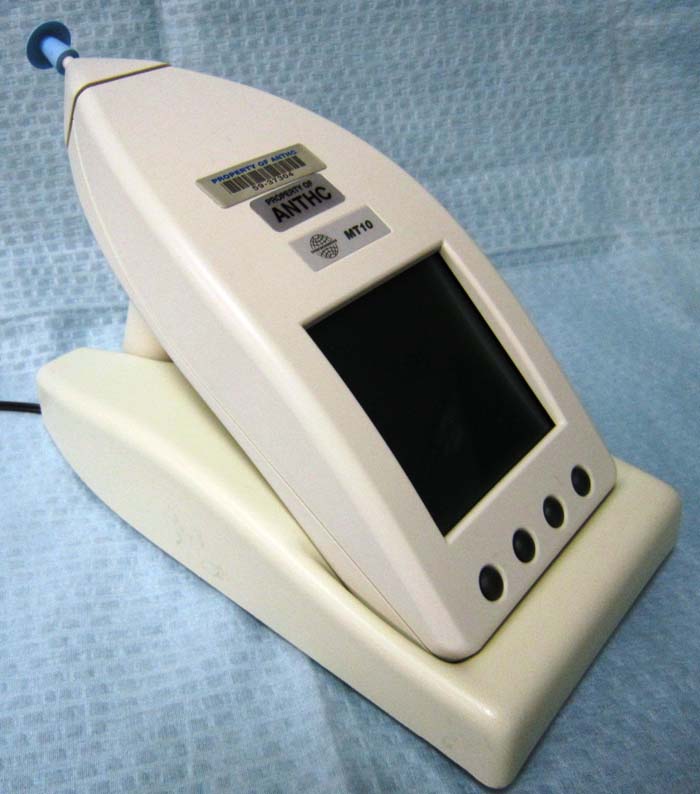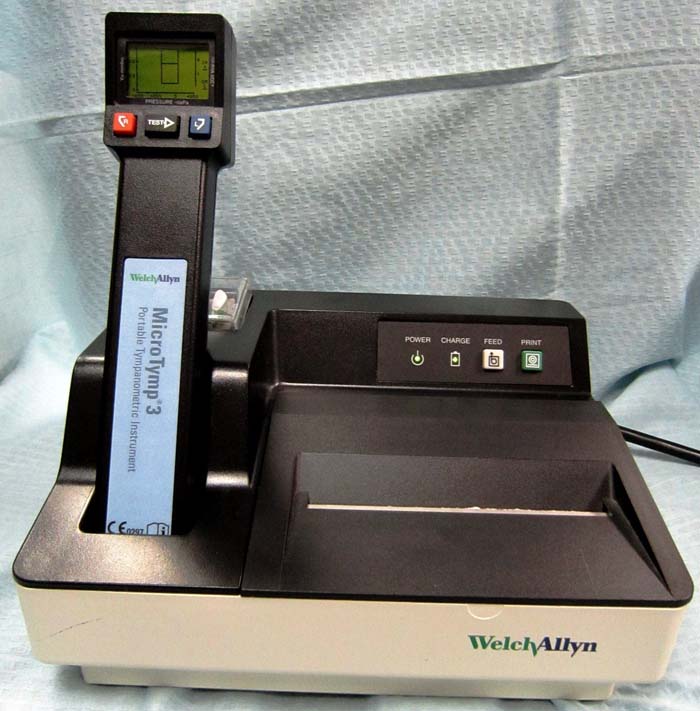GSI 39 Auto Tymp (Grason Stadler)

The GSI 39 Auto Tymp by Grason Stadler
The GSI 39 Auto Tymp is a desktop unit with attached probe that provides a wide range of options in tympanometry, acoustic reflex measurements and audiometry. The unit runs on 120V and the probe is attached to the main unit by cable, so the unit must be attached and plugged in to be operational. The first impression is that of a clean, professional audiology device with a wide spectrum of options. The rectangular box unit has 30 buttons, attenuator knob, present button, LCD display, printer, probe holder, with attached cable and probe. The buttons are well-labeled and sealed. From the patient’s perspective, the device appears non-threatening as just the small probe is presented to the patient and ear. The probe is sleek and has a neutral color with white tip. Compared to the other tympanometers, the GSI 39 has the largest base 15 x 12 x 5.5 inches, but the smallest probe, presented to the patient. The unit weighs only 5 pounds.
The unit appears durable with regard to materials and working parts and has few parts that could potentially break. The probe could be dropped, but the metal nose cone protects the more sensitive probe wire. There is a paper cover that snaps in place over the printer compartment to access and change paper, otherwise there are no other hinged or free parts.
Ergonomically, the buttons, controls and probes are easy to access and straight-forward to use. However, the labeling, icons, controls and multi-functionality are intimidating to a first time user. Still, the TYMP button is easily identified and simple once the user is introduced to it. One can use this device for tympanometry without reading the manual. In that respect, it is intuitive. It is very easy to use this for tympanometry in both an adult and child. It is very comfortable and noninvasive to the patient. There is appropriate feedback to the user, although some of the feedback is small or cryptic on the screen. It is easy to view the screen, although the screen is physically separate from the probe. The probe is so well designed that the user can easily view the probe tip-ear seal. Compared with the other tympanometers, the GSI 39 provides the best view of the probe tip-ear seal. Compared with the other tympanometers the GSI 39 provides the best seal of the tip for both the adult and pediatric ear. Once a user is shown how to use this unit, there are few mistakes made with this device. Compared with other units, this unit was easiest to obtain a seal and quickly perform tympanometry.
Regarding the control features, most items are easy and intuitive with regards to powering on and off, knowing that the unit is turned on, test selection, left and right ear identification, saving tests, memory, avoiding test mix up, erasing data and printing. Minor drawbacks are that the on/off button is located in the back left corner and there is not a method of identifying a patient within the data.
The screen information layout is excellent or very good with regard to graph resolution, graph axis, left and right designation, compliance peak, tympanic peak pressure, ear canal volume, gradient width, test status and seal status. Some indicators are on the screen and all appear as color codes on the probe (226 Hz) with regards to ready to start (blinking green), test in progress (steady green), leak (orange) and occlusion (yellow).
The LCD screen monitor is 3.2 x 10.3 cm and has an approximate viewing angle of 90 degrees. It is very good in terms of size, brightness, glare free, contrast, resolution and text clarity & readability. It is not a color display; rather it has two shades of LCD green/blue.
The printer has a printing indicator, worked well, seems reliable and is fast (5 sec). The paper quality is very good and it is easy to change. The print quality is very good with excellent data layout.
Maintenance includes calibration check, simple cleaning and probe care and is straight forward. Compared with other units, the GSI 39 offers the best way to clean and care for the tip. The probe nose cone can be screwed off to remove cerumen and other debris; the cone can be washed and even autoclaved.
The GSI accessories include the ear tips and volume tool test cavity which are high quality and excellent. The operation manual, clinical instruction manual and service manual are excellent.
EasyTymp (MAICO)
The EasyTymp by MAICO
The easyTymp by MAICO is a portable handheld tympanometer that fits into a docking station base and offers tympanometry and acoustic reflex testing. The first impression is that of an unknown new device, as most clinicians have not seen this style or shape of tympanometer. The name “easyTymp” is printed on the front so users will understand it is a tympanometer. The unit appears modern, clean and professional with a blue and tan color coordination. The unit has interesting soft corners and curves. From the patient’s perspective, the device may be a little intimidating because of its size as the user approaches the ear. The easyTymp base measures approximately 11.5 x 6 x 4.5 inches and the handheld portion 12 x 3 x 3.5 inches. The easyTymp docking station base plugs into 120V with a plug power adaptor 24 V 1.0 Amp. The handheld unit is powered by 3.6 V 1850mAh Lithium Ion Battery Pack (Model No. 74101501). The battery within the tympanometer is charged while it is docked in the cradle. A separate battery can charge in the battery charger slot. The handheld unit needs to be carefully pushed into the docking station to make sure it connects and is charging.
The unit appears durable with regard to materials and working parts and has few parts that could potentially break. Like all portable units, the hand held portion has the risk of being dropped. This would cause high risk to damaging the tip. It is meant to reside within the docking station, but it can be removed and placed on a surface without rolling off or falling over. There is a hinged printer paper cover that is released by the front button, but requires a fingernail or paper clip to slip under the plastic cover to lift it open. There is a slide off battery compartment door on the hand held unit.
There are seven navigation buttons on the handheld unit and these are similar to a cell phone navigation tool to select options from the small cell-phone-like screen. These buttons are easily accessible but take some time to get used to the navigation and screen selections. Most users would be able to pick up this device, select the test and perform tympanometry without reading the manual. There is appropriate feedback to the user, although the screen is small.
The easyTymp is pretty user-friendly and works well for tympanometry in adults and children. The tip probe is small, slim and the tips are comfortable to the patient. It is somewhat easy to see the probe tip-ear seal. The easyTymp provides a very good seal of the tip for the adult and pediatric ear. Once a user is shown how to use this unit, there are few mistakes made with this device. Compared with other units, this unit was O.K. to obtain a seal and quickly perform tympanometry.
Regarding the control features, most items are intuitive with regards to knowing that the unit is turned on, test selection, left and right ear identification, saving tests, memory, avoiding test mix up, erasing data, battery charging indicator and printing. Minor drawbacks are that the on/off is not intuitive. You turn on the easyTymp by pressing the right or left arrow key; turn off easyTymp by pressing both keys at the same time.
The screen information layout is very good to excellent with regard to graph resolution, graph axis, left and right designation, compliance peak, tympanic peak pressure, ear canal volume, gradient width, test status and seal status.
The LCD screen monitor is 3.5 x 4.5 cm and has an approximate viewing angle of 120 degrees. It is very good to excellent in terms of brightness, contrast, color, resolution and text clarity. However, it is a small screen with tiny data and graph; there is also some prominent glare.
The printer has a printing indicator, worked well, seems reliable and is fast (6 sec). The paper quality is very good and it is easy to change. The print quality is very good with excellent data layout.
Maintenance is straight forward and includes a calibration check, with simple cleaning and probe care. The easyTymp offers an excellent method for removing the probe for cleaning by pressing the button at the back of the unit. There is a cleaning tool included to clean the probe tip. The probe tip can also be removed to fit with the optional ear-bud-type external probes.
Standard accessories include Probe 721-2m Rechargeable Battery Pack 721-4, Software CD 1156-2075, easyTymp® handheld unit 721-1, Probe Tip 721-3, Eartip Kit 721-5, Instruction Manual 1162-1100, Calibration Cavity 721-7, Power Supply (Handheld Unit)** 721-6, Power Supply (Cradle)** 721-9, USB, Cable for Handheld* 1025-2097 and the USB Cable for Cradle* 1025-2092.
*Will contain only one, depending on configuration ordered.
** Will contain only one, depending on configuration ordered.
Optional accessories include the Cradle without Printer 721-10, Cradle with Printer 721-8, Wall Mount Kit 6699 and the Carry Case 1035-3024.
The ear tip box includes the following type of ear tips: Flanged 3-5mm, Mushroom 9 mm, Mushroom 11 mm, Mushroom 13 mm, Mushroom 15 mm, Mushroom 19 mm, Umbrella 15 mm, Umbrella 19 mm, and the MAICO Probe Cleaning Tool. The easyTymp includes an excellent operation manual.
MT10 (Interacoustics)
The MT10 by Interacoustics
The MT10 by Interacoustics is a portable handheld tympanometer that fits into a docking station base and offers tympanometry, acoustic reflex testing and hearing screening. The first look gives the impression of a radar-gun-shaped device in a docking station. With the Interacoustics logo and “MT10” printed on the front, a first time user will probably not know that it is a tympanometer. The tan unit has a minimalist retro appearance with large handle, big screen and four plain buttons. From the patient’s perspective, is intimidating because it has a large gun shape and may evoke a little fear when approaching one’s ear. As one patient stated, “You are going to put that thing in my ear?!” MT10 base measures approximately 9 x 5 x 2 inches and the handheld portion 10 x 6 x 2 inches. The MT10 docking station base is powered by 120V that feeds through a 3 x 3 x 6.5 inch 10V 1.9 Amp transformer brick with on/off switch. The handheld unit is powered by three AA rechargeable batteries (NiMH 1200 mAh or NiCa 750 mAh) and they do charge while seated properly in the charging station. The handheld unit needs to be placed correctly onto the docking station so that the DC connections contact the live pins. A subtle red indicator light appears when adequate contact is made.
The unit appears durable with regard to materials and working parts and has few parts that could potentially break. Like all portable units, the hand held portion has the risk of being dropped. The unit would be unlikely to fall directly on the tip because it is weighted on the downward button portion of the handle. The MT10 tympanometer fits nicely onto the docking station and it also sits firmly upright on a flat surface because the thick handle makes for a solid leg. There is a printer slide drawer that pulls out to change the paper. There is a slide off battery compartment door on the hand held unit.
There are four simple navigation buttons below the LCD screen of the handheld unit and these correspond to text above them that changes with different screens. These buttons are easily accessible but take some time to get used to the navigation and screen selections. Most users would be able to pick up this device, select the test and perform tympanometry without reading the manual. There is appropriate feedback to the user on the large screen.
The MT10 is pretty user-friendly and works well for tympanometry in adults and children. The tip probe is medium and the tips are comfortable to the patient. It is somewhat easy to see the probe tip-ear seal. The MT10 provides a very good seal of the tip for the adult and pediatric ear. Once a user is shown how to use this unit, there are few mistakes made with this device. Compared with other units, this unit was O.K. to obtain a seal and quickly perform tympanometry.
Regarding the control features most items are intuitive with regards to knowing that the unit is turned on, test selection, left and right ear identification, saving tests, memory, avoiding test mix up, erasing data and printing. Minor drawbacks are that the on/off is not intuitive; the unit turns on by pressing any button, but there is no on/off indicator. Also, there is no battery level nor charging indicator. The screen information layout is very good to excellent with regard to graph resolution, graph axis, left and right designation, compliance peak, tympanic peak pressure, ear canal volume, gradient width, test status and seal status.
The LCD screen monitor is 6.5 x 6.5 cm, the largest of the tympanometers tested. The viewing angle is more narrow at approximately 60 degrees. It is very good to excellent in terms of size, contrast, resolution and text clarity. However, it is less bright and has some prominent glare. It is not a color display; rather it has two shades of LCD green/blue.
The printer has a printing indicator, worked well, seems reliable but it is slow (15 sec). The paper quality is very good and it is easy to change. The print quality is very good with excellent data layout.
Maintenance includes calibration check, simple cleaning and probe care and is straight forward. To dismount MT10 probe tip, one loosens the fitting screw with a few turns and pulls out the probe tip. The probe tip can also be removed from the main housing for a more convenient and stable positioning of the ear tip in the ear canal when testing e.g. infants or scared children.
Standard included parts for the MT10/MTP10 include MT10, MTP10 Base station with built-in high speed thermal printer, charger and interfacing to PC, TPR10 3 rolls of thermal paper, EPS11 power supply, RCB10 3 NiMH rechargeable batteries, BET50 set of ear tips, operation manual and multilingual CE instructions for use. The operation manual is very good.
Additional parts include IFC69 cable for PC connection (9 pins), IFC59 cable for PC connection (25 pins), ACC10 carrying case for MT10+MTP10, TPR10 3 rolls of thermal paper, BET50 set of ear tips, PrintView, IaBaseII and Diagnostic Modules and the Ia-NOAH-Imp module.
MicroTymp 3 (Welch Allyn)
The MicroTymp 3 by Welch Allyn
The MicroTymp 3 by Welch Allyn is a portable handheld tympanometer that fits into a docking station base and offers tympanometry. The first impression is the unassuming appearance of an otoscope, making it familiar to the clinician and appear unimposing to the patient. The black and tan rectangular docking station is powered by a 120V cord, and together with the black hand-held unit, appear professional and well matched. The base measures approximately 9.5 x 7.5 x 5 inches and the handle is 12 x 3 x 3.5 inches. The handheld unit fits nicely in the docking station and is powered by the proprietary Welch Allyn #72910 3.7 V Lithium Ion battery that charges from the docking station.
The MicroTymp 3 appears durable with regard to materials and working parts and has few parts that could potentially break. Like all portable units, the hand-held portion has the risk of being dropped. The base is sturdy and has a recessed pocket to hold a small tray of ear tips. There is a small side card holder for screening result cards. The base station has a power indicator, charge indicator, feed button and print button.
Like all portable units, the hand held portion has the risk of being dropped. While the handheld portion fits in the docking station, it is a bit loose and could become dislodged and fall if incidentally bumped. The handheld unit rests awkwardly on its side when out of the base station. There is a paper access cover that pulls off to change the paper. There is a battery compartment door on the hand-held unit that requires the removal of a small Phillips-head screw.
The MicroTymp 3 handle has a small LCD screen with three buttons below: Test, Left Memory, and Right Memory. The controls are easy to use, but the left/right buttons are confusing as the user has a tendency to push them before the test and press the wrong side. Generally speaking, most users would be able to pick up this device and perform tympanometry without reading the manual. There is excellent feedback to the user when the unit is blocked or leaking.
The MicroTymp 3 is pretty user-friendly and works well for tympanometry in adults, but is more difficult with children. The tip probe is larger in size and makes it more difficult in children. The ear tips are medium quality. It is difficult to see the probe tip-ear seal as the head of the unit obstructs the view. The MicroTymp 3 provides a fair seal of the tip for the adult and pediatric ear. Once a user is shown how to use this unit, there are few mistakes made with this device. Compared with other units, this unit was O.K. to obtain a seal and perform tympanometry.
Regarding the control features, most items are intuitive with regards to knowing that the unit is turned on, test selection, saving tests, avoiding test mix up, erasing data and printing. However, it is not intuitive to press the R and L buttons after the testing, leading to mistakes. There can also be erroneous printing if only one ear has been tested. The memory for the other ear should be erased so as not to mix current data with data from a previous patient. A minor drawback is that the on/off is not intuitive; the unit turns on by pressing any button, but there is no on/off indicator. The unit times out after 15 seconds and that is sometimes annoying or inconvenient. There is no battery level indicator, until the battery is low.
The screen information layout is very good to excellent with regard to graph axes, normal, test status and seal status. However, the LCD screen has larger blocks for data points making the graph resolution poor. In addition, the screen is small and so the Left and Right Designation, Compliance Peak, Tympanic Peak Pressure, Ear Canal Volume and Gradient Width data are very small and difficult to read on the screen.
The LCD screen is very small and the viewing angle is approximately 90 degrees. It has very good contrast but only fair brightness, resolution and text clarity. It is less bright and has some prominent glare. It is not a color display; rather it has two shades of LCD green/blue.
The printer has a printing indicator, worked well, seems reliable and is fast (4.5 sec). The paper quality is very good and it is easy to change. The print quality is very good with excellent data layout.
Maintenance is straght forward and includes a calibration check, and simple cleaning and probe care. The Welch Allyn MicroTymp 3 User Manual and Service Manuals are excellent. There is also an excellent Instructional Quick Reference Sheet.
Welch Allyn Replacement Parts and Accessories include Handle #23650, Battery #72910 3.7 V Lithium-ion, Screw for Battery Cover # 236081, Screw Driver for Battery Cover # #236200-2, MicroTest Cavity #711772-501, Probe Tips – Four of the selected size in a bag (#24621 Black Extra Small, #24622 Gray Small, #24623 Blue Medium, #24624 Green Large, #24625 White Extra Large), Box with two sets of tips #24620, MicroTymp 2 and 3 Paper #56100, Spindle for Paper #761050-1, Card Holder #55260, 1000 Hz Screening Results Cards #55270, Handle #23650 and Carrying Case #05276-U.



